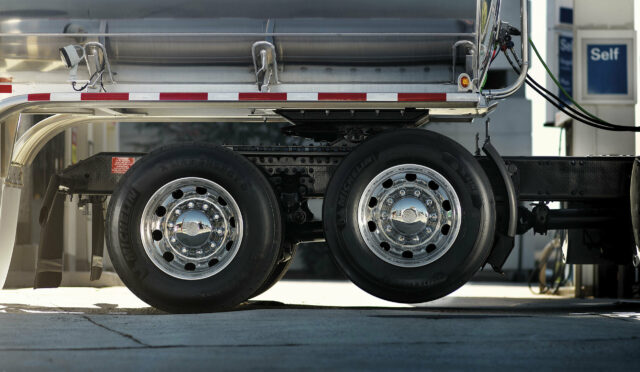
How 6x2 Suspension Increases Fuel Efficiency and Tire Life
As a self-described “efficiency nut,” Joel Morrow has spent his 30-year career behind the wheel trying to extract the most productivity possible out of his rig. With nearly four million miles logged, Morrow has had plenty of time for trial-and-error and keeps exacting records on his deliveries in order to measure and evaluate the impact of his fuel efficiency efforts.
In fact, his habit of documenting his trips in terms of total miles, miles per gallon (both driving and idling) and average speed on LinkedIn have made him somewhat of a social media sensation in the trucking industry. He collected more than 1,400 LinkedIn followers within his first six months of tracking his progress, bolstering his reputation as a trucking efficiency expert. This has presented him with speaking opportunities and an offer to compete in the Run on Less competition, the first-of-its-kind, cross-country roadshow aimed at demonstrating how Class 8 trucks can use different technologies to achieve the best fuel economy possible.
Joel Morrow Is a Firm Believer in the 6x2
The 6×2 configuration with adaptive loading is the not-so-secret ingredient to Morrow’s fuel efficiency achievements. He has been operating his current vehicle, a Volvo® 6×2 with adaptive loading with only the base specifications, for the past year and has logged nearly 150,000 miles. He can attest to the greater fuel efficiency, improved traction and increased tire life it provides.
Link® Manufacturing’s commitment to collaborative engineering played an important role in the development of the pusher axle suspension that the Volvo®/Mack® configuration uses to achieve greater fuel economy, improved traction and extended tire life. Over a two-year research and development phase, Link engineers worked hand-in-hand with a team from Volvo/Mack to design a 20K non-steerable auxiliary axle suspension with a 9” drop to alleviate issues with driveline clearance. An R-series wheelend was used so all tires could be uniform. This also helped to better manage inventory levels, as all tires would use common components such as brake drums, disc wheels, and hubs.
Link also took great care to design the pusher axle suspension so it could be installed within the exacting manufacturing process that Volvo/Mack employs, which only provides a five-minute installation window before the vehicle moves to the next phase of the assembly. All of this combined to make the Link pusher axle suspension system an integral component in the successful rollout of the 6×2 configuration in North America. In fact, this collaborative effort has resulted in Volvo/Mack regularly referring to the product as the “Link Pusher Axle.”
Morrow has always been a firm believer in the performance capabilities of 6×2 truck configurations. In fact, Morrow first learned how to drive a big rig behind the wheel of a 6×2. His firm, Ohio-based Ploger Transportation, has been running various 6×2 configurations since 1968, long before most U.S.-based companies. It was his familiarity with this configuration and intense focus on efficiency that resulted in Volvo engineers seeking his help to test the initial 6×2 with lift logic and adaptive loading capabilities.
Always Measuring, Always Improving
Morrow is serious about measuring his truck’s performance. He not only benchmarks against North American Counsel for Freight Efficiency (NACFE) averages of fleets in the U.S., but his firm also owns standard 6×4 configurations and tag axle 6x2s so he can be even more confident when comparing the numbers of adaptive loading 6x2s versus other options.
The truck Morrow currently drives is getting remarkable results of 0.3 mile-per-gallon better fuel efficiency and 47% longer tire life than the tag axle trucks his firm runs, which he expects to improve as they learn more about manipulating the logic. He is also experiencing one-half MPG better than the 6x4s. There are a few more variables when comparing tire life to his 6×2 with adaptive loading and a 6×4.
6x4 Techniques Don’t Add Up
One of the ways drivers of standard 6×4 configurations have attempted to increase fuel efficiency is to use low rolling resistance tires. In this situation, tires are inflated toward the upper-end of the inflation scale, resulting in a very small tire footprint and less resistance, which is intended to provide efficiency gains. In Morrow’s opinion, this is less than ideal, as it results in running slip and faster tire wear, which the driver may not even realize is happening because it’s difficult to feel.
When Ploger tested low roll tires with its 6×4 benchmarking truck, the results were disappointing,
“We did exactly what everybody else does, we put the low roll tires on and inflated them to 115 psi and got only 156,000 miles on that set of tires before they had to come off. I’ve got tires on my 6×2 with 225,000 miles that still have a lot of life. Now if you put a standard traction tire on a 6×4, you can get outstanding tire life, upwards of 400,000 miles with a decent driver, but the fuel efficiency just crashes.”
To demonstrate this point, Ploger had one of its best drivers achieve just 6.8 MPGs running the 6×4 benchmark truck with standard traction tires. But with adaptive loading on a 6×2, running the same route, the same driver got close to 9 MPGs, a 30% increase over the 6×4. Those results were proven true over multiple tests.
“With the 6×4 you have a lot of trade-offs that aren’t ideal. You can either have fabulous traction and tire life, but it costs you fuel economy or you can get decent fuel economy but it costs you in tire life. There’s no really good balance, which is why so many have embraced the 6×2,” explained Morrow.
Safety can be another concern with low roll tires, particularly in inclement weather.
“It’s a good way to wind up in the ditch,” noted Morrow. “A really skilled driver can handle it, but with your typical fleet driver, the number of driver complaints, incidents and accidents outweigh any fuel efficiency gains you’ll see. You’re much better off with using auxiliary lift axles with adaptive loading, where you get that right balance between rolling resistance and traction. Because we’re lifting an axle off the ground at certain times and optimizing the tire foot print when it needs to be optimized, you have the best of both worlds.”
With Link, the Rubber Literally Meets the Road
Some might consider traction to be too subjective to measure and quantify, but Morrow believes the correlation between traction and tire life tells the true story of how well a vehicle handles. Simply put, the worse your traction the shorter your tire life. After all, the more slipping that occurs—whether on the road or spinning at the loading dock—the faster rubber is worn and the sooner you’ll be back in the shop.
Morrow has experienced a dramatic increase in the tire life and correlates that with increased traction the 6×2 provides.
“The Lake Tahoe area had 22 feet of snow this past winter, and anytime I was running up Donner Pass on I-80 I had zero traction problems getting in and out of places. It was very rare that I even had to put chains on the tires, even when they had the chain up signs out,” exclaimed Morrow.
His tire life improved 45-50% versus a 6×2 tag configuration without any reduction in fuel efficiency. While increased traction often comes at the expense of fuel efficiency, that hasn’t been the case for Morrow.
“Because we’re lifting an axle off the ground at certain times and optimizing the tire foot print when it needs to be optimized, you have the best of both worlds. You get outstanding traction and really good efficiency at the same time which is very hard to do with a 6×4, if not impossible.”
An Additional Benefit of Adaptive Loading Is Driver Comfort
Another benefit of the 6×2 with adaptive loading is driver comfort. When it senses weight differentiation it automatically lifts the axle to reduce friction, resulting in a smoother ride, particularly with light to medium loads. That’s something drivers who spend most of their day behind the wheel will appreciate. In Morrow’s estimation, the Volvo/Mack system with the Link Auxiliary Suspension is the only one on the market that will effectively bias its weight to the drive during transit.
“Hendrickson has a 6×2 liftable out but it does absolutely no weight biasing and so that makes the Volvo/Mack system with a Link lift axle clearly superior to the Hendrickson system.”
Morrow’s Drive Toward 10 MPG
As Morrow works toward his new goal of 10 MPG, he sees future enhancements with the 6×2 configuration featuring auxiliary lift axles playing the most important role, rather than engine improvements.
“To me it’s always about improving efficiency through the drive line rather than tampering with the engine. While they’ve made improvements in various engines, I think you get a biggest bang for your buck with a super-efficient drive axle in the transmission specifically.”
Link products are available and can be ordered through Link’s nationwide network of dealers. For more information on Link products or to find a dealer, please call (800) 222-6283 or visit https://www.linkmfg.com/dealers.


